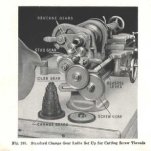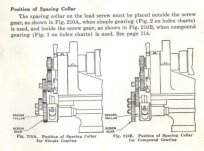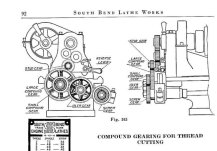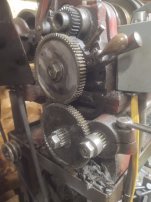Is there a setup method for a math dumb dumb to cut spirals (AKA very coarse shallow threads) with an old SB 9C? The spirals are oil movers.
One is 15/16“ between the grooves. .938 tpi?
I have trouble just expressing these pitches.
The other is 1/4“ between grooves. 4 tpi?
In my writing this, did I actually figure out the pitches? Hehe, nah can’t be.
Your thoughts?
Swami sees the future of my start to experimenting with the gear train and a marker in a tool holder for testing. If wrong, wipe it off.
The factory did it in the 20‘s and 30‘s and I’m guessing with a lathe.
Alas, the fellow that made repro’s/repops isn’t anymore.
Five different diameters, two different spirals, two different keyways and one hole thru.
One is 15/16“ between the grooves. .938 tpi?
I have trouble just expressing these pitches.
The other is 1/4“ between grooves. 4 tpi?
In my writing this, did I actually figure out the pitches? Hehe, nah can’t be.
Your thoughts?
Swami sees the future of my start to experimenting with the gear train and a marker in a tool holder for testing. If wrong, wipe it off.
The factory did it in the 20‘s and 30‘s and I’m guessing with a lathe.
Alas, the fellow that made repro’s/repops isn’t anymore.
Five different diameters, two different spirals, two different keyways and one hole thru.








